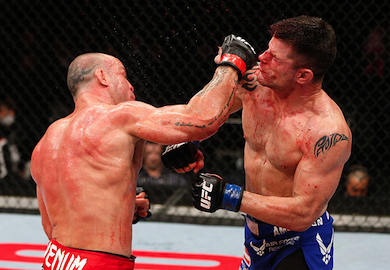Researchers Say Brain Trauma Occurs in 30% of MMA Fights

A Canadian study revealed information that could take athlete safety inside the octagon to the next level.
The American Journal of Sports Medicine recently published a study that critiques how safe the sport of MMA really is. The study revealed that mixed martial arts fighters suffer a traumatic brain injury in three of every ten fights they partake in. This means a fighter like Dan Henderson who has fought in 41 fights throughout his career sustained brain damage in 12 of those fights.
It was also noted that this rate is higher than that of hockey or football.
Professor Hutchison, University of Toronto faculty member, conducted the experiment without any actual medical diagnoses of MMA fighters. Despite that, this study is sure to catch the attention of media. National Post stated the following:
“The study conducted by Prof. Hutchison and doctors at St. Michael’s Hospital in Toronto did not involve actual medical diagnosis of MMA fighters.
Instead, they analysed the publicly available scorecards from professional UFC matches, which indicate whether a fight ended in a knockout or TKO. While not definitive evidence, it is probable that a knockout, where the fighter loses consciousness, involves a concussion or more severe brain injury, said Prof. Hutchison.”
The report continued and stated that Hutchison and his fellow researchers suspect that the sport is more dangerous than hockey, football and even boxing.
“They detected an average of 6.4 knockouts per athlete for every 100 fights, or ‘athlete exposures.’ When the multiple-strike TKOs were added, the total of suspected brain injuries climbed to 15.9 per athlete per 100 bouts, or one concussion-like injury in 32% of matches.
That compares to rates, found in other studies, of 4.9 concussions per 100 athlete exposures in boxing, 2.2 per 100 in hockey and 8.08 per 100 in football, the paper said.”
They also insisted that the sport be banned for youth participation and the professional leagues make the sport safer.
While this is a positive step for athlete safety inside the octagon, this report is flawed in many ways. The next logical step for a more accurate report is to pull the medical records of fighters and base the statistics off of those. Until then, these numbers are strictly intelligent-estimates, at best.
This article appeared first on BJPENN.COM
Previous Post
Topics:
UFC NEWS








